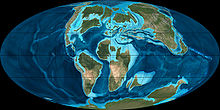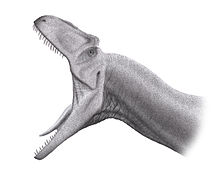- Dinosaurs of New Zealand
-
 How the Earth looked during the Cretaceous period. New Zealand is connected to Australia and much closer to the South Pole, allowing creatures from different continents to come to NZ.
How the Earth looked during the Cretaceous period. New Zealand is connected to Australia and much closer to the South Pole, allowing creatures from different continents to come to NZ.
Although the evidence is rare, fossils reveal that there were dinosaurs in New Zealand. Possibly because it lacks the right conditions for fossilisation, only fragments of bone and a few vertebrae have been found there.
Because these fossils are only a single bone or a piece of a bone, the dinosaurs' species cannot be identified, but by comparing the fossils with others it can be seen which family or order a given fossil belonged to.
Marine fossils are more common than fossils of land animals in New Zealand because dead animals and plants are easily preserved in sand and mud. Therefore, some fossils of large marine reptiles are nearly complete, and so can be identified to species.
Species
So far, there have been fossils found in New Zealand that have been identified as coming from:
Non-Avian
Name Period Diet Notes Ankylosaur Cretaceous Herbivore Probably a Nodosaur similar to Minmi. Compsognathus-like creature Jurassic Carnivore Known from toe or finger bone. Hypsilophodont Cretaceous Herbivore Very large; possibly not a Hypsilophodont but an Iguanadont. Joan Wiffen's Theropod Cretaceous Carnivore Probably an Allosaur. Titanosaur Cretaceous Herbivore Known from trace fossils and a rib. Unidentified Theropod Cretaceous Carnivore Known from toe bone around the size of the Tyrannosaurus's. For the avian dinosaurs of New Zealand, go to the list of birds of New Zealand.
Other Mesozoic Animals
Fossils of other animals from the Mesozoic Era have also been found in New Zealand. All of them lived in the sea aside for the Pterosaur. These creatures include:
Name Period Diet Ichthyosaur Triassic Carnivore Possibly an early Platypterygius Kaiwhekea Cretaceous Carnivore - Liodon Cretaceous Carnivore The maximum length of NZ species is 30 ft. Mauisaurus Cretaceous Carnivore Largest plesiosaur in New Zealand. Moanasaurus Cretaceous Carnivore Largest mosasaur in New Zealand. Mosasaurus flemingi Cretaceous Carnivore Junior synonym of Moanasaurus. Nothosaur Triassic Carnivore - Pontosaurus Cretaceous Carnivore - Prognathodon Cretaceous Carnivore - Pterosaur Early Cretaceous Carnivore Possibly Mythunga. Rikkisaurus Cretaceous Carnivore Junior Synonym of Moanasaurus. Saurichthys Triassic Carnivore Prehistoric barracuda. Sphenodon Mesozoic-Holocene Carnivore Extant. Taniwhasaurus Cretaceous Carnivore - Tuarangisaurus Cretaceous Carnivore - Tylosaurus haumuriensis Cretaceous Carnivore Synonym of Taniwhasaurus. Dinosaurs that live in the Ross Dependency, a part of Antarctica within the Realm of New Zealand include the 20 foot long carnosaur Cryolophosaurus, sometimes nicknamed Elvisaurus because of the shape of its head crest. It is important to remember that the Ross Dependency, unlike the Chatham Islands, is not actually part of New Zealand, and this is why it is excluded from the list above until sufficient evidence shows that it entered what was the sector of Gondwana that is now New Zealand. For more dinosaurs of Antarctica, click here.
Tuatara
Tuatara, the common (Māori) name for three species of reptile in the Sphenodon genus, is referred to as a "living dinosaur". From a taxonomic viewpoint this is incorrect. Sphenodon species evolved before dinosaurs emerged and were displaced by them.[1]
See also
- Reptiles of New Zealand
- Fauna of New Zealand
- Geology of New Zealand
References
Categories:- Extinct reptiles of New Zealand
- Dinosaurs
- Dinosaurs by continent
Wikimedia Foundation. 2010.




